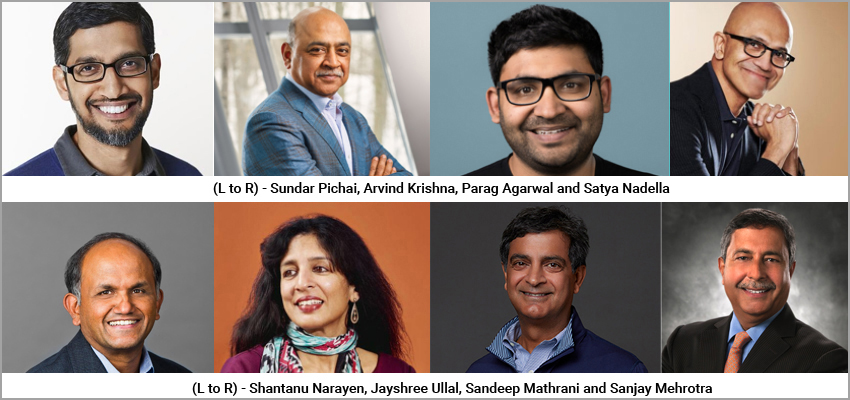
CORPORATE CITIZEN CLAPS FOR INDIAN-ORIGIN CHIEF EXECUTIVE OFFICERS (CEOS), MANAGING 58 TOP GLOBAL COMPANIES.
To be precise, Union Finance Minister Nirmala Sitharaman has acknowledged that Indians are managing 25% of start-ups in Silicon Valley in the U.S. According to Standard and Poor›s (S&P) listing, Indian CEOs in the top 500 companies come almost next to their U.S. counterparts. The Indian pride is that most have completed their education in India and steered themselves amongst the global corporate diaspora. India can boast of 11 such multinational firms, and all 58 companies manage a collective revenue of $1 trillion with a turnover of close to 4 trillion. The latest entrants to the top-notch list include Devika Bulchandani, CEO of ad agency Ogilvy, and Laxman Narasimhan, CEO of Starbucks. They have joined the list of seasoned prominent CEOs of Indian origin, including Chanel›s Leena Nair, Alphabet›s Sundar Pichai, Microsoft›s Satya Nadella, and Parag Agrawal, leading Twitter. The authors of ‹The Other One Percent: Indians in America state reasons for their success, saying that the talent finds progress due to the drastic shift in the 1960s U.S. immigration policy. According to a BBC report, Indian-born Silicon Valley CEOs are also part of a 4 million-strong minority group among the wealthiest and most educated in the U.S. Not surprisingly, the diaspora of talented Indians also includes about a million scientists and engineers. More than 70% of H-1B visas for foreigners have been issued to Indian software engineers, and 40% of these Indian-origin engineers have found their path across Seattle. With India›s working population slated to overtake China in 2028, as per the 2019 U.N. population data, India›s working-age population is expected to reach 65 % by 2036. The need is to tap the youthful talent and hone them as future global leaders. R Gopalakrishnan, former executive director of Tata Sons and co-author of ‹The Made in India Manager,› observes that the domestic competition and chaos in India make individuals problem-solvers, and these characteristics enable top leaders anywhere in the world. «The fact that they (Indian origin CEOs) often prioritize the professional over the personal helps in an American office culture of overwork,» he said.
CORPORATE CITIZEN SLAPS INDIA’S CONSTANT HEALTHCARE ECONOMIC BURDEN, LARGELY BORNE BY HOUSEHOLDS CONTRIBUTING RS 3,24,717 CRORE TO THE CURRENT HEALTHCARE EXPENDITURE.

The 2018-19 National Health Accounts Estimates, released on September 12, 2022, stated the Union government’s healthcare spending share at Rs 63,256 crore, the state government’s share at Rs 1,06,056 crore, and local bodies contributing Rs 5,451 crore. Non-governmental organizations spend Rs 8,484 crore, while external/donor funding contributed to about Rs 2,493 crore. According to the latest national health estimates, India’s total health expenditure went down from 3.9 % of the GDP in 2013-14 to 3.2 % in 2018-19. Sanjay Mohanty, a professor at the International Institute of Population Sciences, who has been tracking health spending patterns, said, “The falling ratio tells us that our spending on health is lagging behind our economic growth - or the GDP has grown faster than the country’s increase in health spending.” He reiterated that government spending does not match their spending goal of 2.5 % of the GDP, as set in the 2017 National Health Policy. However, government-financed health insurance did rise 167 % from Rs 4,757 crore to Rs 12,680 crore, bringing some relief to the out-of-pocket household healthcare expenditure that declined significantly from 64.2 % of the country’s total health expenditure in 2013-14 to 48.2 % in 2018-19. The data reveals state-wise disparities too. In Uttar Pradesh, the out-of-pocket health expenditure accounts for 71.3 % of the state’s total health expenditure (THE). The high out-of-pocket health expenditure share in terms of THE in other states mentioned includes West Bengal (68.7 %), Punjab (65.5 %), Odisha (53.2 %), Telangana (48 %), and Himachal Pradesh (45.8 %). “The fall in private (household) health expenditure is good, but government spending needs to go up commensurately for the total health spending to stay the same,” said Indrani Gupta, professor and specialist in health economics at the Institute of Economic Growth. Industry experts believe that the central and state governments must provide specialist healthcare to all and not just pump resources into creating giant hospitals in the cities. Good public healthcare is a citizen’s right and has to be delivered closest to villages, towns, and cities.